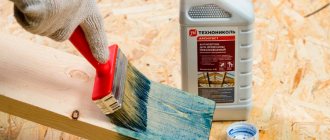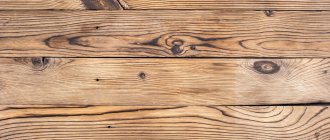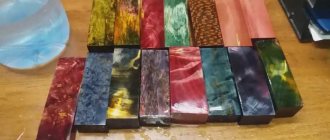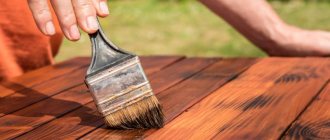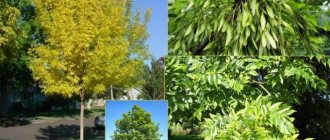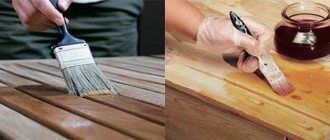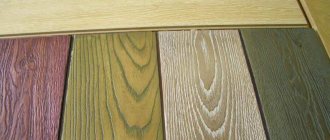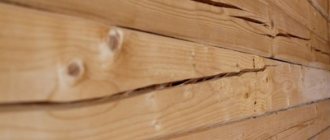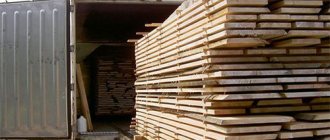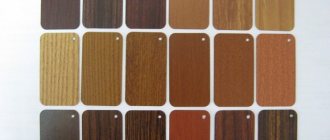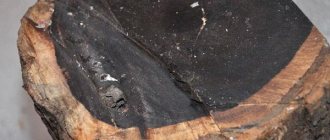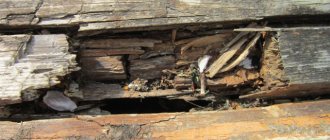Wood warping is a defect in which lumber changes its original shape and warps. This occurs due to non-compliance with the rules of drying and mechanical processing, high humidity and swelling, and excessive internal tension of the tree. This defect worsens the appearance and complicates wood processing, reduces strength and reduces the grade of lumber. In addition, many warped products cannot be used for their intended purpose.
Make an anti-splinter guide for sawing and milling
You can make two guides (1.2 m and 2.4 m long) to use with workpieces of different lengths. These guides, designed to work with a specific circular saw and router, can be made from a single sheet of plywood 13 mm thick. (We recommend using plywood with both sides sanded.) Here's how to do it.
- Using a chalk cord, mark a line along the entire sheet of plywood at a distance of 280 mm from the edge. Cut the sheet along this line with a circular saw.
- Make the remaining cuts along the guide, using the factory edge of the cut strip as this. From the remaining part of the sheet, cut two strips 51mm wide, two strips 203mm wide and one strip 280mm wide.
- Saw the plywood strips to the length shown in the picture above, and then assemble the guides. Carefully remove any exposed adhesive.
- When the glue has dried, secure the guides to the workbench, leaving an overhang necessary for further trimming. Using a circular saw with the blade you normally use, make a cut along the wide edge of the fence, running the saw along the fence as shown below. Do the same from the other edge of the guide, but using a router. In the future, when milling along the guide, use a cutter of the same diameter as for the initial trim.
How to treat wood with protection against rot, fire and insects
Wood materials and products are quite often subject to fire, rotting and damage by insects. How can wood be treated to reliably protect the material?
Wood rotting is caused by wood-destroying fungi.
The occurrence of this process is possible if three conditions are present:
- wood moisture content is in the range of 20-60% (wood with a moisture content of less than 20% and more than 60% does not rot);
- air temperatures ranging from +2 to +40 °C (at lower and higher temperatures, wood-decaying fungi do not develop);
- high air humidity, which prevents the wood from drying out.
The best means of protecting wood from rotting and insects are antiseptics - substances that prevent rotting. They are used for baths, saunas and other rooms with high humidity.
Antiseptics are divided into four groups: oils; oil- and organic-soluble; soluble, slightly washed out of wood; water-soluble, easily washed out of wood.
One of the best means of protecting wood are oil- and organic-soluble antiseptics based on volatile solvents - pentachlorophenol and copper naphthenate. Antiseptic treatment of wood with pentachlorophenol almost does not reduce its physical and mechanical properties. Wood impregnated with copper naphthenate does not glue well, is poorly polished, and is painted greenish.
When impregnated with wood, water-soluble, weakly washed out antiseptics penetrate the walls of its cells. The most common is sodium pentachlorophenolate. Experts, answering the question “how to treat wood against rotting,” often advise using the Selkur composition. It destroys wood staining and mold fungi and does not affect the quality of wood when gluing and painting. The Selkur composition protects wood from rotting when used in environments with high temperature and humidity.
Water-soluble, easily washed-out means of protecting wood from rotting and fire include chloride and fluoride zinc and sodium, as well as the preparation BBK-2. These antiseptics do not affect the physical and mechanical properties of wood, with the exception of sodium silicofluoride and zinc chloride, which reduce its strength. They are used as an impregnation of wood that is not subject to constant exposure to moisture during operation.
You can distinguish wood impregnated with antiseptics from unimpregnated wood if you add pigments to the antiseptic in an amount of 0.1% by weight.
Compositions of aqueous solutions of antiseptics (% by weight):
- ammonium silicofluoride - 4.9; water - 95;
- magnesium fluoride - 4.9; water - 95;
- zinc fluoride - 4.9; water - 95;
- zinc chloride - 4.9; water - 95;
- sodium pentachlorophenolate - 4.9; water - 95;
- dinitrophenol—3; soda ash—1; water - 96;
- sodium hydroxyphenolate - 4.9; water - 95;
- sodium fluoride - 4; technical ammonia - 1.7 (in terms of dry matter); water - 94.2;
- sodium fluoride - 2.2; sodium fluoride - 0.7; water - 97.
Compositions 1 and 8 are prepared at a water temperature of 30-40 °C, the rest - at a temperature of 95 °C.
To protect wood from insects, insecticides are also used: solutions of hexachlorane, chlorophos, metaphos, chlorophos, copper sulfate, various naphthenates, as well as solutions of brown and sulfuric acids.
How to treat wood to increase fire resistance? To do this, the material is coated with fire retardants - fire retardants. When heated, fire retardants melt, covering the wood with a fire retardant film that blocks the access of oxygen. Wood coated with fire retardants does not burn, but smolders. Fire-retardant wood protection products include sulfite-clay pastes (clay solutions with added salts), chloride paints, salt solutions - borax, ammonia, sodium phosphate and zinc chloride.
Shrinkage and swelling of wood. Warping.
Why are several properties of wood included in the title of the article? It’s very simple - both shrinkage and swelling cause not only changes in size but also warping of the wood.
Already at the stage of harvesting lumber, we obviously receive boards that will warp during drying. This occurs due to the uneven drying of the layers of wood. Layers further away from the core dry faster. Therefore, warping occurs in a “boat” manner, and the middle boards have almost no warping, but towards the edges the boards become noticeably thinner. This defect is eliminated by jointing and drawing parts to the required thickness, as well as by gluing panels from narrow strips of wood. (There are many more different types of warping in wood, but the principles for eliminating them are almost the same.)
During drying, the dimensions of the parts change. The average value of these changes is approximately equal to:
- along the fibers - 0.1 - 0.3%
- across the fibers (in the tangential direction) - 6 -10%
- across the fibers (in the radial direction) - 3 - 7%
But these values are valid only for shrinkage from the fiber saturation point to an absolutely dry state, i.e. for complete drying.
But have you noticed that light stripes appear on your doors along the edges of the panels in the summer, and in the fall they disappear. This suggests that wood, even coated with varnish or paint, still reacts to changes in humidity in the environment. The tree "plays". And it will play for the rest of your life.
We will talk about how to avoid the appearance of these stripes when we talk about making doors.
Of course, the carpenter does not need to know the exact numbers by how much the width of a particular part is reduced? But when making furniture from solid wood, you need to understand the meaning of drying out and warping. You need to understand that you shouldn’t rely on modern glues and screws, as many carpenters do. Just as no amount of asphalt will stop the roots of a growing tree, no block tightly screwed to the bottom of the tabletop will save it from bending. After all, the reduction in size in the transverse direction, as we wrote above, is 10-12 times greater than in the longitudinal direction. So the old masters used the “dovetail” for inserting bars into the tabletops, as well as the “floating” method of attaching them to the table frames.
And frame structures are less susceptible to warping and deformation than large glued panels.
I also saw torn doors and other paneled structures. This was precisely the result of the swelling of the panels. An inept or inexperienced craftsman forgot to give free rein to the panels when assembling the doors, or even, thinking that he would thereby strengthen the structure, gave them stickers.
But I will tell you about all this later, in the section “Making carpentry.”
The photo taken from the website forest.geoman.ru shows various types of warping of lumber.
Share on social media networks
To My World
0
Tweet
Last messages
- Terrace fencing. Review and Mounting Method06/22/2016
- Grinding Wheels GravMan. Return20.06.2016
- #4Exhibition “Woodworking”.06/16/2016
Popular Posts
- What is more profitable: buying or making a chest of drawers yourself? Price review03/12/2015
- What to name the book?02/17/2014
- How to calculate the cost of carpentry.11/28/2013
Classification of defects and defects of wood
Vices
Various shortcomings of individual sections of wood are called, reducing its quality and limiting the possibility of use.
These defects arise in a growing or felled tree due to climatic conditions, mechanical and biological damage, as well as a number of other reasons.
Usually in woodworking, wood defects are considered as a factor that complicates the work and reduces the quality of the wood. In wood carving, on the contrary, many types of defects are quite acceptable, and sometimes form an essential part of the artistic design.
So it is useful for a wood carver to know about the various defects of wood, to know their characteristics and to be able to handle them.
Let us first consider the general classification of wood defects, and then talk about their varieties in more detail.
Wood defects are divided into the following groups:
- knots;
- cracks;
- defects in the shape and structure of the trunk;
- fungal and biological damage;
- chemical stains;
- foreign inclusions;
- defects (or mechanical damage and warping).
Defects include defects of mechanical origin that arise during harvesting, transportation, sorting and mechanical processing of wood.
BITCHES
Knots are parts of branches (their bases) embedded in the wood. There are seven types of knots:
- By position
- face (i.e. boards or bars facing the face); edge (extending to the edge of the board); rib; end; stitched (if the cross-section of a knot extends simultaneously onto two edges of the same side of the board);
- according to the shape of the knot cut on the surface of the material - round, oval, oblong;
- by relative location - group, scattered, branched;
- according to the degree of overgrowth - open and overgrown;
- according to the degree of fusion - fused knots; partially fused; unfused; falling out (i.e., knots that do not grow together with the surrounding wood and therefore do not hold securely);
- at the exit to the surface - one-sided knots and through knots;
- according to the condition of the wood - the knots are healthy; horny; weakened; loose; healthy knots with cracks; rotten; rotten; tobacco Healthy bitches
have no signs of rot. They are painted either in the color of the surrounding wood, or in a slightly darker color.
Horny bitches
have healthy wood, but are richly impregnated with resin and tannins. Painted much darker than the surrounding wood. Often have increased hardness. Dried wood is prone to falling out.
Weakened knots
surrounded by healthy wood, but already affected by the initial stages of decay. At this stage, the wood of the knot still retains its structure and hardness, but in some places (and sometimes completely) changes its color.
Loose knots
are surrounded by healthy wood and have not yet lost their shape, but their own wood has already completely or partially lost its original structure and has softened quite a lot.
Tobacco knot
- this is a rotten knot in which the rotted wood, completely or partially, is a loose mass that easily crumbles into powder. The mass has a rusty-brown color, reminiscent of the color of tobacco, hence the name.
Knots are an inevitable and most common wood defect. This defect worsens the structure of the wood and complicates its processing.
For most types of carving, wood with knots is of little use, so wood without knots is chosen or the knots are removed and special inserts are made.
There are, however, varieties of carving in which knots not only do not spoil the appearance of the product, but are also included as an integral part of the artistic design. In addition, knots are sometimes used separately from wood in the manufacture of various women's jewelry and other small decorative items.
Wood moisture content
but length into layers 4 mm thick.
By measuring the length of these layers before and after cutting, the change in their dimensions is determined and the relative deformation of each layer is found. The second section is sawn into layers 8-10 mm thick; the resulting blocks with the direction of the fibers perpendicular to their length are used to determine the elastic modulus (under static bending with loading at two points). Based on the obtained values of relative deformation ε and elastic modulus E, stress a is calculated for each layer using the formula: Based on the data obtained, a stress distribution curve (diagram) is constructed over the thickness of the board (Fig. 37). The magnitude of residual stresses after chamber drying is significantly higher than after atmospheric drying. Hardwood lumber has higher residual stresses than softwood lumber. Thus, in the surface layer of beech boards, the compressive residual stresses reached 45 kg/cm2, and the tensile stresses in the inner zone were 22 kg/cm2, while for pine boards the stresses were 16 and 8 kg/cm2, respectively.
With some complications (taking into account shrinkage and making appropriate corrections when determining relative deformation, preventing the blocks from drying out to determine the elastic modulus), the described method can also be used to measure internal stresses in wood during the process of atmospheric drying and at the end of chamber drying (with uneven humidity along the section of the assortment). Warping of wood is a change in the shape of the assortment when drying or moistening. A distinction is made between transverse and longitudinal warping.
Rice. 37. Diagram of residual stresses in a pine board after chamber drying.
Transverse warping is expressed in a change in the cross-sectional shape of the assortment. For example, the square cross-section of a block after drying becomes rectangular and even rhombic, a flat board takes on a grooved shape, etc. Transverse warping is caused by the difference between radial and tangential shrinkage: the inner (facing the core) face of the board is closer to the purely radial direction, and the outer - to tangential, so the dimensions of different parts of the boards change differently. The greater the transverse warping of boards made from a given log, the closer to the core the board is located.
Longitudinal warping is observed in two types: in the form of bending (along the length), when a straight board becomes arched after drying, and in the form of twisting, when a flat board takes the shape of a helical surface. The first type of warping is caused by the difference in shrinkage along the grain between two zones of wood (for example, if a block contains both sapwood and heartwood or normal and lurch wood), the second is a consequence of the inclination of the grain. In Fig. Figure 38 shows different types of longitudinal and transverse warping.
To plan or not depends on your machines
After the boards have acclimatized in the workshop, you can choose one of two options. Either first level one face on a planer and thicknesser the other to make them flat, and then proceed to straighten the edges, or straighten the edges, leaving the faces untreated. We recommend the first option, since some methods of preparing the material work better when the faces of the boards are cleanly planed.
However, the choice may be dictated by the capabilities of the available machines. For example, you cannot process a 200 mm wide board on a planer with a maximum planing width of 150 mm. And by sharpening both sides of the board in a thickness planer, you will not make them flat, but only parallel to each other. In this case, make one of the edges of the board straight by first sawing it evenly on a saw to the required width, level one face using a planer, and then plan the board to the desired thickness in a planer. If the required width of the workpiece is greater than the length of the knives of your planer and jointer, then simply saw it lengthwise into two or three sections, sharpen them and process them with a thickness planer, aligning the edges. After the plots become straight and rectangular in cross-section, connect them again into a shield, gluing them with edges.
Warping and shrinkage
Fig. 1. Warping and shrinkage of boards cut from raw logs.
A board warped during drying (Fig. 1) bulges towards the core of the log. This is explained by the fact that the surface of the board, more distant from the core, shrinks more, since the direction of shrinkage here approaches tangential. A board cut from the middle of a log will, after drying, take on a different shape, shrinking in thickness at the edges more than in the middle. Wide boards warp more than narrow ones, so when making joinery panels, boards with a width of no more than 100-120 mm are used.
In a glued board, warping can be significantly reduced if the boards in it are positioned so that the convexity of the annual layers faces not one, but different directions; the same is achieved by connecting the boards into a tip, on dowels and into a frame, for example in the construction of doors where the panel can dry out without warping.
Reasons for board deformation
The main reason for damage to lumber is failure to maintain the drying technology, which leads to cracking of the material. Cracks at the ends appear due to the peculiarity of moisture evaporation - it leaves the wood faster along the layer than perpendicular to the surface. Therefore, the edges of the boards are painted before drying. Experienced craftsmen buy timber with a reserve length, and then cut off the defective sections.
cracking options: along the edges of the board, in the middle and inside
Cracks in the middle of the board occur when drying quickly. Narrow cracks, up to three millimeters, appear in the middle of the sample. Rapid drying causes the appearance of defects in the form of small cracks along the entire length of the material. This flaw can be identified upon purchase by examining the front side of the board. Small defective areas can be cut out and the remaining parts used. Another option for correcting defects is to hammer wedges into large cracks, fill them with epoxy resin, process them and use them for their intended purpose. The presence of internal cracks is difficult to detect - only when cutting the board, for example, when cross-cutting.
After drying, a board for a wooden terrace may be deformed in various planes, but the building material can be restored. Below are some expert tips for dealing with warped boards.
Types and characteristics of the defect
Warping reduces the quality of lumber and wood products, complicates wood processing and increases the amount of waste. In addition, such wood is difficult to paint, sand and varnish. Warping can be of three types:
- Transverse is associated with the swelling of wood in several directions and is determined by the cross-sectional shape of the lumber. It represents the bend of the product along its width;
- Longitudinal appears when sawing a log or beam due to the content of certain defects and defects of the wood, including knots, tilt, tilt of fibers, etc. Represents the bending of the product along its length in a plane;
- Helical represents a spiral curvature along the length of the lumber.
Warped products are subjected to lengthy additional mechanical processing. To reduce warping, materials are dried in a clamped state under conditions that do not cause large internal stresses. Finally, moisture-heat treatment is done. This relieves residual drying stress. Please note that when wood is used during and after drying or when moistened, the degree of warping may change.
To avoid such a defect, it is important to select high-quality and durable wood with a dense structure. In addition, you need to follow wood processing technology, storage and transportation rules. Store lumber in a clean, dry and well-ventilated area. Proper storage will prevent the formation of many defects and defects, including warping, rotting, mold and mildew, and wormholes.
Planer and jointer is the main machine for straightening edges
If you work with unplaned lumber, you really need a good planer. This is the best tool for getting a straight, clean edge that is exactly at right angles to the face (photo below), as well as for cleaning and leveling the face of the board. Although models with a planing width of 150mm work well, consider purchasing a machine with a planing width of up to 200mm. In addition to allowing you to process wider boards, this machine also features longer front and rear tables to provide better support for long workpieces.
A relatively straight board can be planed to a straight and perpendicular edge in just one or two passes.
We do not recommend using auxiliary receiving and feeding stands with the machine, as a board with uneven or curved edges may tip the stand, causing damage to the board by the blades of the machine.
The main defects that occur when drying wood:
- under-drying of the entire stack of lumber;
- their uneven drying over the volume of the stack and over the thickness of the assortment;
- unacceptably large warping of lumber during drying;
- cracking;
- mold;
- collapse;
- shells.
Causes of drying defects and their prevention:
- Under-drying of wood occurs when lumber is unloaded from the chamber ahead of schedule, due to unsatisfactory control of the drying process or a deliberate violation of technology (for example, due to an urgent need for material). Systematic monitoring of compliance with drying technology is necessary.
- Uneven drying according to:
- the thickness of the material occurs with the use of a forced drying process at a significant final moisture content of the wood. It is necessary to carry out final moisture-heat treatment (aging), which is mandatory for lumber of quality categories I and II;
- the length of the stack is a consequence of uneven distribution of air or its heating along the length of the chamber, as well as the unsatisfactory condition of the doors. It is necessary to adjust the uniformity of air distribution and its heating, and also replace the doors with insulated, sealed ones;
- the width of the stack is observed when there is little air movement, it is necessary to shield the stack to avoid the flow of air in addition to the material, and also to increase the air supply by fans. As a palliative solution, sparse placement of material in places where it is not dry is used;
- stack height occurs due to non-verticality of the rows of spacing (in chambers with natural circulation) and poor air circulation. it is necessary to improve the stacking of lumber and upgrade drying chambers to reversible ones;
- stack volume is observed with weak air circulation, stacking of different assortments, double stacking of lumber, use of wide (more than 40 mm) blanks as spacers, stacking of blanks in a cage with frequent spacers, etc. Such defects in stacking are not allowed.
- Warping of the material during drying, both longitudinal and transverse, is a consequence of poor clamping, i.e. its unsatisfactory stacking. Warping after drying occurs when there is moisture and elastic deformations in the dried material, therefore it is necessary to carry out proper final moisture-heat treatment of dried lumber and not load it until the wood has completely cooled, i.e. Cool only in stacks. The occurrence of cracks inside the material and finished products occurs due to the equalization of moisture across the thickness of the material after drying. The prevention method is strict adherence to operating parameters in the second stage of drying and proper final moisture-heat treatment of the material after drying.
- Cracking of the ends and faces of materials occurs during a forced process at the beginning of drying; it is necessary to soften the drying mode. Cracking of freshly sawn ends of boards and blanks is observed at the very beginning of the drying process due to their rapid drying. The prevention method is to protect the end zones with screens that reduce the speed of the drying agent and thereby reduce moisture transfer by reducing the coefficient of moisture conductivity along the fibers.
- Mold on the material appears when there is stagnant air circulation. It is recommended to increase air movement, increase its temperature, and apply moisture and heat treatment.
- Collapse or wrinkling of wood occurs during chamber drying of oak and some species, eucalyptus, ash, poplar, willow, and cypress. Externally, the collapse manifests itself in the fact that lumber takes on the appearance of “washboards”, and the cross-section of lumber and bars changes its shape. To prevent it, lumber should be pre-dried either in atmospheric conditions or in special pre-riders before kiln drying.
- The appearance of shells in the second stage due to the accelerated process in the first stage. It is necessary to carry out intermediate moisture-heat treatment of the material according to stage II.
Worst case significant bend
Before processing such a board, first determine how best to dispose of it. By removing the bend from a 3 m long board, you will waste a lot of wood, as the photo below shows. If you really need a long board, try to choose a board with less curvature. If you absolutely need to get long workpieces from heavily curved boards, you have three options: cut them lengthwise with a circular saw, use a sled for a circular saw, or use a band saw with an extended fence - provided that the length of the workpieces does not exceed 0.9 m. Processing on a bandsaw, longer boards will only create additional complications.
